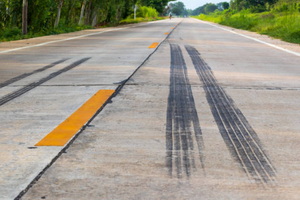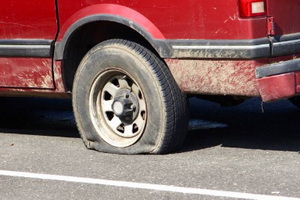News
What Are the Risks of Using Worn-out Tires?

Flat tires at midnight. Hydroplaning on a rainy commute. That awkward thump-thump-thump at high speeds. These aren’t plot twists in a horror movie – just everyday consequences of driving on worn-out tires. Problem is, many people ignore the slow creep of danger beneath their vehicles. Let’s talk about how risky it really is… and why your tires deserve better.
Worn-out tires can reduce traction, increase stopping distance, and raise your chances of skidding or blowouts. They’re more likely to hydroplane in rain, slip in snow, or even burst in heat. Driving on them isn’t just risky – it’s a game of roulette. Regular checks and timely replacements – like switching to Joyroad’s performance, touring, or all-season designs – help keep you (and your passengers) far from danger.

Want to know more? You’re in the right place. Let’s get into the nitty-gritty of why good tires matter and bad ones bite.
1.Why do worn tires reduce grip?
Because bald isn’t beautiful – at least not on tires.
You wouldn’t wear socks with holes in them to a snowball fight. Worn tires are just as ridiculous when it comes to maintaining grip, especially on slippery or curved surfaces. The less tread a tire has, the less it can “bite” into the road surface. That means traction takes a nosedive.
Less tread, less confidence
Tread isn’t just a fashion statement. It’s designed to channel water, grip the pavement, and adjust to small changes in terrain. When it wears thin, you’re relying on smooth rubber to do the work of engineering. That’s like expecting a butter knife to cut steak.
When tires are worn down, their ability to interlock with road texture decreases. Whether you’re braking, turning, or accelerating, they simply can’t hold on as well. This lack of grip gets worse in rain or snow, when friction matters most.

The domino effect on safety
Loss of grip doesn’t only mean minor slips. It can trigger a chain reaction – from unsteady steering to outright skidding. Emergency maneuvers become less reliable, and even simple lane changes feel riskier. It’s like doing yoga on an icy deck.
Bottom line: grip is your tire’s love language with the road. Worn-out ones are just not that into you anymore.
2.How does tire wear affect braking distance?
More than you’d think – and less than you’d like.
The distance it takes your car to stop can balloon if your tires are worn. It’s not an exaggeration – bald tires can increase stopping distance by over 50%, especially on wet roads. Imagine slamming the brakes and still sliding into next week. Not ideal.
Friction failure under pressure
Good tread creates friction, which is what helps your car slow down. When that tread is worn, there’s less surface area working in your favor. The contact patch gets smaller, and the rubber has less grip. You press the brake pedal with confidence, and the tires respond like, “Eh, we’ll see.”
This problem worsens in rain or snow. Water gets trapped between the tire and the road, and without tread grooves to channel it away, you may as well be braking on Jell-O.

Every second counts
Braking distance doesn’t just matter for you. It matters for the kid chasing a ball into the street, or the car that stopped short in traffic. A few extra feet might be the difference between “phew!” and “oh no.”
And don’t forget: your car’s fancy safety features? They rely on good tires too. So don’t blame the ABS when it feels like you’re driving a toboggan downhill.
3.Can worn-out tires cause blowouts?
Oh yes, and they do it with flair.
You might think a blowout is rare – like finding a parking spot downtown – but it’s surprisingly common, especially with worn-out tires. Those bald patches can hide internal damage or weaknesses just waiting for the right pothole to say “surprise!”
Weak rubber, big consequences
As tires wear, their structural integrity weakens. The sidewalls become thin, and tiny cracks form that you can’t always see. Throw in heat, friction, and road debris, and it’s a recipe for sudden disaster. One good bump, and boom – your tire turns into a confetti cannon of panic.
Blowouts don’t just destroy the tire; they throw your vehicle off balance. Imagine holding a grocery cart with one broken wheel, now add highway speed to that equation. Not fun.

The chain reaction you didn’t ask for
When a tire explodes, it doesn’t politely deflate – it disintegrates. That can damage your rim, your suspension, or even your undercarriage. If you’re lucky, you’ll pull over in time. If not, you might find yourself sideways in a ditch explaining tire maintenance to a tow truck driver.
So yes, worn-out tires can blow out – and they won’t even apologize afterward.
4.Is hydroplaning more likely with worn tires?
That’s a big wet YES.
Hydroplaning happens when water builds up between your tires and the road, lifting the tire off the surface. It’s not fun. It feels like your car’s floating, but not in a luxury yacht kind of way – more like an inflatable pool toy with a slow leak.
Tread depth to the rescue – or not
New tires have channels and grooves that actively push water aside, allowing rubber to maintain road contact. When those grooves wear down, they become ineffective, and the water has nowhere to go. Result? Your car suddenly moonwalks across the asphalt.
This is especially dangerous at highway speeds, where even a momentary loss of control can end with a long call to your insurance company.

Wet roads and slippery regrets
Worn tires increase hydroplaning risk dramatically. And let’s not forget – hydroplaning doesn’t just cause a thrill ride, it disables your ability to steer or brake. You’re basically a passenger in your own car, hoping Newton’s laws of motion go easy on you.
Moral of the story? Keep your tread deep and your stress levels shallow.
5.Are worn tires noisier?
Only all the time.
Ever drive a car that sounds like it’s dragging a marching band behind it? That’s often worn-out tires doing their own thing – loudly. Tread patterns are engineered to minimize road noise, and once those patterns fade, the harmony breaks down.
When your tires sing off-key
Without proper tread, tires vibrate differently against the road. They produce inconsistent frequencies and echo more – especially at higher speeds. The result is a low droning hum or an annoying whine that could rival your in-laws on a road trip.
As the tread thins, the sound insulation decreases too. So every pothole, expansion joint, and gravel patch gets broadcast directly into your cabin like a late-night infomercial – but with less variety and more rattling.

This isn’t just an irritation – it can mask more serious noises from the vehicle, too.
Louder = Rougher ride
Noise is usually accompanied by vibration and bumpiness. The rubber doesn’t cushion the ride the way it used to, so you feel every pebble and hear every complaint. It’s like riding in a blender – but one that costs money every time you start it.
Replace worn tires and you’ll bring back the silence. Your ears will thank you. So will your passengers. And probably your mechanic, who’s tired of pretending the noise is “normal.”
6.Are all types of vehicles affected the same way?
Sadly, no one is spared.
Whether you drive a zippy compact, a hulking SUV, or a commercial van, worn tires throw everyone under the bus – sometimes literally. No matter the size, shape, or horsepower, tread depth still matters.
Heavier vehicles, heavier problems
Larger vehicles, like SUVs or light trucks, often carry more weight. That means more pressure on tires, and more risk if one fails. A worn tire on an SUV can feel like skating in hiking boots – unstable and not very stylish.
Cargo vans and trucks carrying tools or goods can lose grip faster than you can say “backorder.” Add a wet road and a tight delivery schedule, and it’s a recipe for a very sideways morning.

Meanwhile, smaller cars may seem nimbler, but they rely even more on tire performance for safety and handling.
Electric vehicles aren’t immune either
EVs are often heavier than gas-powered cars due to battery packs, making good tires even more crucial. Plus, their instant torque can be harsh on tread wear. If your EV tires are worn, your range, control, and silence could all suffer.
Also, regen braking can be less effective with low traction – not ideal when you’re coasting toward a red light with the smug satisfaction of not using gas.
So yes, all vehicles suffer from worn tires – they just each suffer a little differently.
7.How often should I check my tires?
More often than you floss, ideally.
Let’s be honest: we all say we check our tires regularly – like we say we drink enough water or call our parents. But tire checks are easy, fast, and can save your life. Do them monthly. Yes, monthly.
A penny can save plenty
The penny test isn’t just folklore. Insert one into your tread with Lincoln’s head upside down. If you can see all of Abe’s noggin? It’s time for new tires.
Also, inspect for sidewall cracks, bulges, or uneven wear. These could signal deeper issues like alignment problems or overinflation. Trust your eyes, and don’t wait for the squealing sound.

Check tire pressure too – preferably when tires are cold. Underinflated tires eat fuel. Overinflated ones bounce like they’re auditioning for a trampoline team. Neither is great.
Don’t forget the spare!
Most people forget they even have a spare. But if you do, make sure it’s inflated and damage-free. It won’t help much if it’s as worn as the ones you’re replacing.
Set a reminder if you must. Your tires will thank you – and so will your alignment, your fuel tank, and your passengers. And if nothing else, you’ll finally win that smug satisfaction of being more prepared than your neighbor.
Conclusion
Worn-out tires aren’t just old – they’re unsafe. Grip vanishes. Braking suffers. Blowouts loom. And even your fuel bill gets fatter. It’s time to take tire wear seriously. Stay sharp, check often, and choose replacements – like Joyroad – before the rubber really hits the fan.





